Published in the January February edition of The Tomato
Thank you, Mary Bailey. for giving me the opportunity to write about my amazing students and the wonderful things that are happening in the Foods Classroom at Kate Chegwin School!
 Edible Education at Kate Chegwin School
Edible Education at Kate Chegwin School
“Bringing students into a new relationship with food through pleasure by engaging them in a way that is irresistible: tastings, cooking, and nutritious school lunches. “
“œThis one is so juicy and squishy!” Suhkman’s little mouth is full and his eyes, big brown saucers.
“œThis one is sour and puckery.” Markie’s face contorts expressing her taste experience.
“œI like this one the best. It is hard and crunchy and juicy and sweeter, but not too sweeter.” Simran contributes her observations, too busy crunching and munching to even notice if anyone agrees with her, or not.
“œThis one isn’t very dense. It is grainy and too sweet and not very appley.” Tiana decides after she has sniffed, tasted, and chewed her way through a few of the apples on the tasting table.
Providing the apples is easy. Granny Smith, Golden Delicious, Red Delicious, Gala, Macintosh, Fuji and whatever else is available in most stores on a regular basis. The idea is three fold: learn knife safety skills, provide a taste experience for my students, and work at the development of a tasting vocabulary. I don’t need to work on the enjoyment of the activity. That is effortless. Everyone has a blast.
“œThat was so much fun, Mrs. Rodgers! I thought it was going to be so scary with that knife, but it was easy, and I can do it!” Suhkman declared as he left the classroom that day. Proud of himself, full of apples and a new relationship with this food based on taste and pleasure. Such a simple experience, but one that is fresh and profound!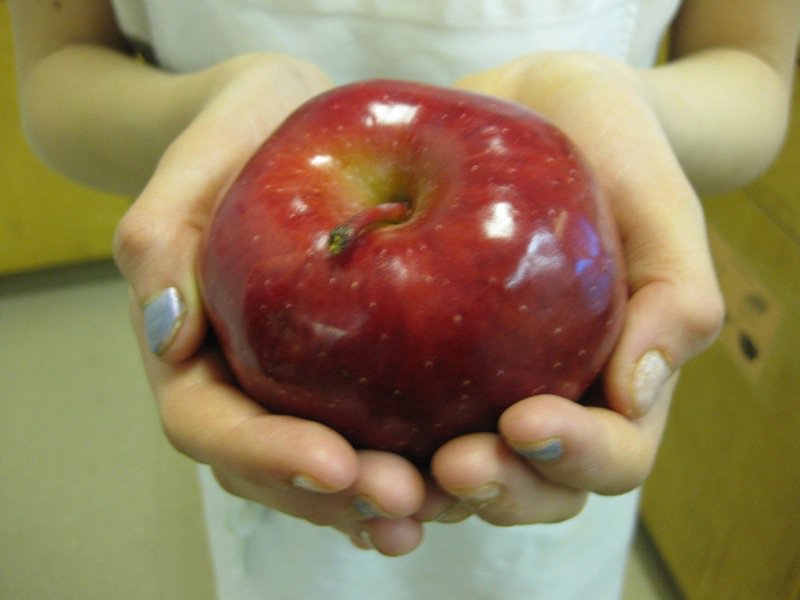
The mouth feel, and texture, the flavour, and taste are all bundled up in the release of a bite and the experience is intensely personal. “œI never had an apple like this before.” “œI didn’t know there were so many kinds of apples.” “œI didn’t know that all of these apples could taste so different but still be kind of the same taste, in a way.”
So simple, yet so profound. Â Engaging my students in irresistible edible experiences is easy, and essential. I focus my students on the irresistible pleasures of food: fresh, delicious, nutritious, raw fibrous fruit. That is where we start. With apples. This is a nurturing process and I work to teach my students how to feed themselves. I bring them to the table, give them love, all wrapped up this day in the apples, knowing they will be nourished and that this experience will forever change their relationship with the apple. And, to a certain degree, with themselves, as they begin to understand their personal palate and the personal power they own, to choose.
Of course, with choice, there are consequences. This I do address, but later.
And, yes, I do talk about the metaphor of the apple as the fruit from the Tree of Knowledge in the Garden of Eden, and explain the symbolism of the apple representing education and knowledge and school and teachers. This is an integration of information that will never be forgotten as all senses are on overdrive in this class.
 Engaging each other and our small children in irresistible edible experiences is easy, and essential. Our apples get sliced, and shared, and the samples and tested and tasted. The appeal of their colours and perfume is intoxicating. “œWhat smells so good?” “œLook at the apples! They smell so new!” “œWhat kinds are these? I didn’t know there were so many different kinds!”
Engaging each other and our small children in irresistible edible experiences is easy, and essential. Our apples get sliced, and shared, and the samples and tested and tasted. The appeal of their colours and perfume is intoxicating. “œWhat smells so good?” “œLook at the apples! They smell so new!” “œWhat kinds are these? I didn’t know there were so many different kinds!”
Who knew it would be that easy to captivate a room full of adolescent students? It is. Tastings are so engaging and compelling. It is necessary for all to experience real and fresh food in its finest form. Why? Because it is delicious, nutritious, and essential for our health.
- 14% of 9 to 12 year olds eat 4 or more servings of vegetables and fruit a day
- 36% of 12 to 19 year olds eat 4 or more servings of vegetables and fruit a day
- 50% of 6 to 12 year olds do not consume any milk products for lunch
- 25% of Canadian 6 to 19 year olds eat French fries twice or more per week
Our children are learning how to become perfect citizens of The Fast Food Nation (Alice Waters, 2006) through the attitude about food and food choices that the adults in their world are modelling for them. The amount of junk and fast foods that we are now consuming, as a nation, is staggering. Our teenagers are addicted to salt and sugar and won’t buy nutritious foods, even if it exists. Our babies are eating French Fries at two years old. That is not cute. Our youth learn inherently through our habits and our reward system. Young children are “œtreated” with a happy meal, or with junk and fast food. Snack Bars and candy sales are too often used to raise money for something. What our students learn about the context of the junk or fast food that is so readily and frequently used to reward them is that this food is an acceptable choice. And, it just is not. They must be taught about food and the consequences of not eating healthy food.
And, what is equally startling is that it is natural for children to love healthy food. They do. If they have access to beautiful fresh fruits and vegetables, and the opportunity to experience the wonder of a variety of tastes, they get excited by the opportunity, the experience, the learning, and the food. If the carrots are dirty, they will follow your lead. They will smell the earth and celebrate the rich minerals that created this beautiful root vegetable. Children and adolescents are full of awe and do understand that a carrot is a miracle of nature. They clean them, peel them, and are so thankful to have them “œstraight from the farm”! Attitudes are contagious. And our young are most susceptible to this.
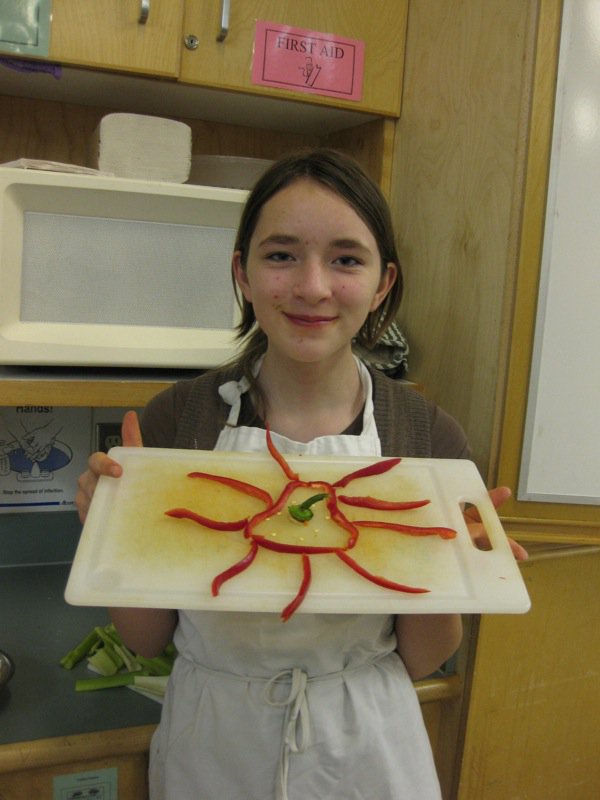 If kids get poor produce, they will not enjoy fresh fruit or vegetables. A spoiled, under ripe, gassed, waxed, and mealy apple is not a pleasurable eating experience. All of the bruised apples, and dried up oranges sent to school in student lunches do end up in the garbage. But the plump, ripe, rosy and fragrant apples or the juicy, fleshy and luscious oranges never get thrown out. The fragrance is contagious. YUM!
If kids get poor produce, they will not enjoy fresh fruit or vegetables. A spoiled, under ripe, gassed, waxed, and mealy apple is not a pleasurable eating experience. All of the bruised apples, and dried up oranges sent to school in student lunches do end up in the garbage. But the plump, ripe, rosy and fragrant apples or the juicy, fleshy and luscious oranges never get thrown out. The fragrance is contagious. YUM!
Over cooked and canned vegetables are also “œyucky”. We are teaching our kids to not love fruits and vegetables. Try buying all kinds of sweet bell peppers and a variety of others: the yellow, the green, the orange, the red, and the black or purple ones, and an Anaheim, a Serrano, and others that are mildly spicy or more varied in flavour than the bells? Buy the most gorgeous ones you can find. Prepare each raw, and steam some. Then have a tasting party at the dinner table. Salt and pepper is enough. Which is better, and why? Children understand that there is no “œright” answer where taste is involved. It is entirely personal, and exceptionally fun.
Getting fresh, nutritious and delicious food is so much fun. Children love to go shopping and learn about the fruits and vegetables in the store. If you buy something with them, they will try it, and are excited to try it because they were part of the process. We must reintegrate food into every aspect of our daily lives as an important part of our sustenance. Because it is.
Children and teens are so eager in the kitchen. Gender is not a barrier. Preparing real food creates a source of pride and honest pleasure in doing real work. Children will try what they have never tried before, if they are a part of this process. This will increase exponentially if they grow it themselves, but that is a whole other story!
“œMrs. Rodgers, we’re going to have so much fun, right? I am a little bit scared though. I am excited, but I am still a little bit scared.” exudes Sukhman on the morning of his first grade seven cooking class. He will be making “œToad in a Hole” all by himself. He is twelve, and he has never had the opportunity to cook at home. This is the norm in my classes. Many of my students tell me they are not allowed. Students need to be a part of the food preparation experience at home. That is the time for talk about food, and the time for instilling the value of food. It is the time for tasting and creating food. It is more important to the development of your child than reading daily. Students love to cook, and always eat what they make. It is that easy
I tell my students that they are going to die younger than any generation before them. I say it passionately. I mean it, and they know I mean it because they feel my passion. There is no dissention in the room. They already know they are making poor food choices. All of them know it by the time I tell them this. They have heard it all before, so many times. They are not capable of making sense of such intangible and distant consequences, and the doom and gloom approach is only momentarily startling. But, I do still take advantage of that moment, then, instead of focusing on these very serious negatives, I focus my students on the irresistible pleasures of food.
Tastings happen in our classroom often. One tasting that consistently surprises me is the potato tasting. We touch, and smell, and peel and taste all kinds of potatoes: purple potatoes, red potatoes, sweet potatoes, yams, white fleshed, yellow fleshed, banana shaped, and baby potatoes. “œI never knew there were so many potatoes!” “œWhy are there so many potatoes?” “œHow come we need this many potatoes?” “œYuck! What does this one taste like? Is that really a potato?” And then we go through it all again.
We scrub our hands, and slice and smell, and test and taste and share and discuss the flavours, and textures, and appeal, or lack thereof. Of course, the initial idea of eating a raw potato is met with shock. Every student is astounded at the vast difference in the taste and texture of the raw potato tasting compared to the cooked potato tasting. Few “œlike” them raw, but everyone is actively engaged in the experience. They now understand the importance of various aspects of potatoes: this one is mealy and is best for mashing, this one is waxy and holds its shape well when cooked, and on and on.
I have about 150 Foods Students every two days. I teach 8 classes of Foods education from grades 7 to 9. That is a lot of food, a massive responsibility, and an incredible opportunity. Low income kids consume the majority of their calories during school hours, and when I arrive at school as early as 7 am there are students in the halls drinking pop and eating chips. The light bulb went on with an opportunity to impact the total health of every child in our school. Students had lamented that the Foods option didn’t fit into their timetable, so, we started the Kate Chegwin Catering Club.
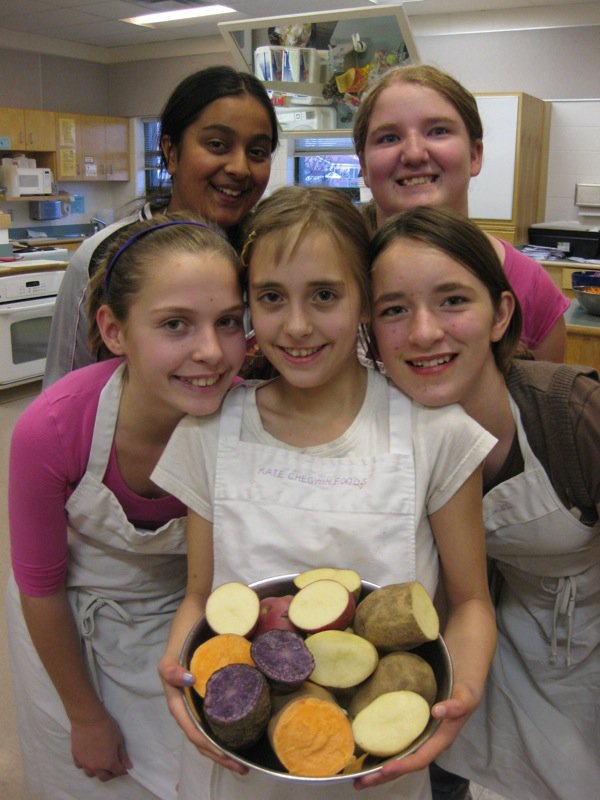 Every Tuesday and Wednesday after school from 3-4:30 I offer tastings, and cooking opportunities for every student in the school. We cater a healthy delicious nutritious lunch to our school public every Friday. We do a cost recovery program so that the lunches are affordable, and my catering club doesn’t have to pay a fee.
Every Tuesday and Wednesday after school from 3-4:30 I offer tastings, and cooking opportunities for every student in the school. We cater a healthy delicious nutritious lunch to our school public every Friday. We do a cost recovery program so that the lunches are affordable, and my catering club doesn’t have to pay a fee.
This small initiative has become a great success. We serve 40 to 80 lunches every Friday. My students deliver the pre-orders, and I make sure I am in the School Store window to “sell“ this lunch each week. Students are afraid to try something new, or not willing to eat what they have not participated in making. So, I explain, answer questions, and reassure. Sometimes, I get out at the morning break with sample tastes of the upcoming lunch. The word gets out. Lunch sells out almost every week; pre-orders come in. More students drop into our club to be part of the experience. We are rockin` and rollin` at Kate Chegwin School. I know I am making a difference in my little corner of the world. It is gratifying, fun, and so incredibly easy.
I overheard a conversation recently, “Why do you devote so much of your free time after school to catering club when you could be playing with your friends.“ Emily’s answer: “It is so much fun and I learn so much. Mrs. Rodgers lets us be independent in our kitchens. If we make a mistake, we learn from it. If we break something, we clean it up. She explains things and lets us help plan and decide what to do. I am kind of in charge, too. “ I had never thought about why they come. I thought I knew. But, this information was valuable to me. Independence and power are great motivators in every aspect of life. You bet I had a quiet little sideways smile pasted to the side of my face when I heard this conversation. I would have kicked up my heals, too, if I had the ability.
Feed our children so they have an interest in food as they will become the new providers for the new generation. Make beautiful meals to inspire your family to come to the pleasures of great food. It is really all about the love.
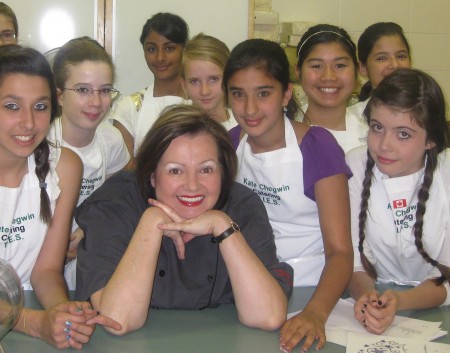
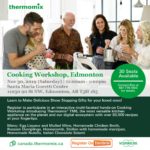
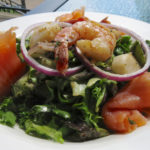


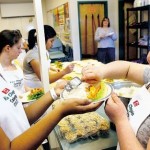
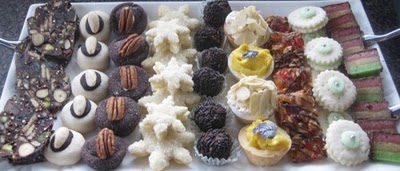



Very cool!
Please keep me posted of upcoming classes and events
Will do so, Jo-Ann!